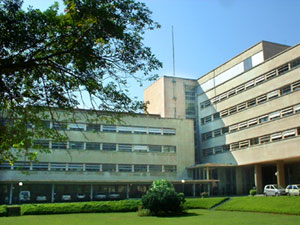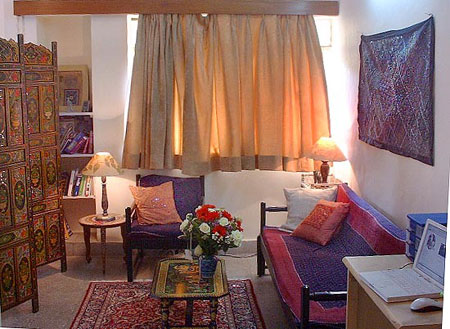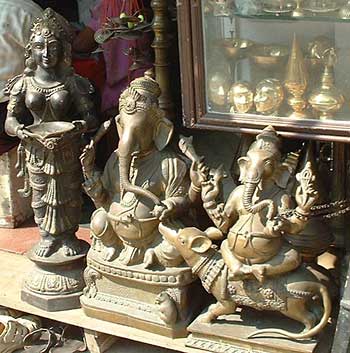At Home in Bombay
(December 21, 2003)
 |
|
The view of Bombay, looking north from our neighborhood. The city is on a peninsula that curves around. |
 |
|
The campus is a small area, with tropical gardens and palm trees sprinkled between the somewhat non-descript concrete buildings. |
 |
|
Okay; we know you're curious. Here's where we live. |
TIFR is located in the end of a navy base. In fact, one of the reasons we have so much trouble with our cell phone is that the frequencies are jammed out here. To get off the base, we have three choices – we can walk about 20 minutes to the nearest area where there are stores, take one of the buses that run on a regular schedule, or take a cab. Walking out of our apartment building, we go through the security gate, and there is a taxi stand – a group of taxi drivers waiting for people looking for a lift. The taxis are all old Ambassadors, which is a standard kind of Indian car – a bit small, and all very old, it seems. None have air conditioning, and at times, it seems quite remarkable that they can start up at all. Still, when you watch the taxi drivers as they wait around, you will often see them cleaning and polishing the cars, stringing garlands on them, and keeping them in the best possible condition. Inside, although the springs to the seat cushions may have seen better days, the seats are usually draped with some sort of fabric. And there is usually a religious artifact of some type posted someplace – perhaps a photo of a swami on a button, or a statue of Ganesh, the elephant god.
We met some people at the US Consulate here, and learned that an assignment to Bombay is classified as a "hardship" assignment. Reasons explained to us included the traffic – yes, it is really a new skill to learn to cross the street here. And the pollution – we notice the pollution not only from the occasional cough, but also from the black coating that so quickly covers the mosquito netting after we wash it. The climate – well, we selected the months of our stay carefully. Oh yeah, and the diseases – well, we boil the water carefully, watch what we eat, take our malaria pills. But putting all that aside, we hardly feel like this would count as "hardship"! There is too much wonder to discover just walking out our door.
 |
|
Ganesh idol, anyone? A shop in Chor Bazaar. |
The streets also generate all manner of sounds and smells: sewer smells and urine, certainly; but also smells of food being cooked in the open stalls along the street, whiffs of jasmine from the necklaces of flowers being sold for women to wear in their hair, or to place at one of the street-side shrines, or who-knows-what all uses. Sounds from the traffic, a rooster, the crows, the hawkers pushing every sort of ware – "ma'am you want to buy…". Every manner of person – old skinny women in soiled saris, high-class professional men in their Indian vests, young women in lovely salwar kameez outfits and a fancy bindi on their forehead, the man with one leg sitting on the street begging… all the vendors on the sidewalk, selling every type of food and clothing, ready to fix your shoes or sell cook you a meal. A construction crew fixing the road, which generally include women in saris carrying buckets of dirt on their heads. Always the mangy stray dogs, a litter of puppies, a skinny cat running to hide.
We are making it our goal to steadily expand our knowledge of the city, taking it on by foot, gradually expanding our mental map northward, carrying our trusty map and bottled water. Yesterday we took on the bazaars, temples and narrow streets north of the Victoria Terminus. We have created a little photo essay of our journey. First is the Crawford Market, a large indoor market that has fruits, veggies, Christmas decorations, paper goods, dry groceries, and many people. From there, we made our way through the narrow streets. The types of stores cluster within an area, so that one block or two is all jewelry; the Brass Bazaar is all pots, pans and anything else made of metal; there is the Flower Alley, where you can buy flowers strung together as a garland and used for presentation at the temple; or the Chor Bazaar, or "thieves market" where we found more antiques and collectibles than even Brimfield can imagine. Sometimes we need to pause to take in the scene – all the characters along the way, the wonderful chaos created by too many vehicles trying to get through a small space (taxis, bicycles, motorcycles, oxcarts, and many many pedestrians), the food stands cooking right on the pavement, all the glorious old buildings. There are moments when it gets a bit much, when a break is needed – and of course, it seems there is never a place for a cup of tea right when we need it – but we finally found just the spot.
As we continue our explorations, we will keep you posted on the new neighborhoods we discover.
<Home
More pictures of Bombay>